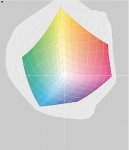Good Day!
is there a way to increase solid densities in digital proofs? i am asking this because we are exploring setting in-house densities for process colors in our press room. If we so decide to increase certain ink densities (to extend the gamut of the press), how can we make the proofer output higher solid densities in order to match our boosted densities in press?
it is my observation that currently our proofer is outputting consistent control bar colors when we make our proof. we are using epson 9900 and metadimension.
is there a way to increase solid densities in digital proofs? i am asking this because we are exploring setting in-house densities for process colors in our press room. If we so decide to increase certain ink densities (to extend the gamut of the press), how can we make the proofer output higher solid densities in order to match our boosted densities in press?
it is my observation that currently our proofer is outputting consistent control bar colors when we make our proof. we are using epson 9900 and metadimension.














